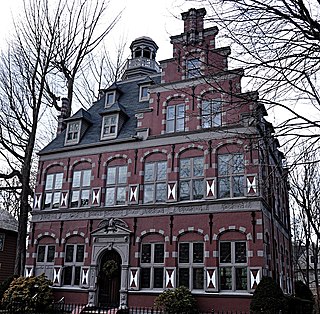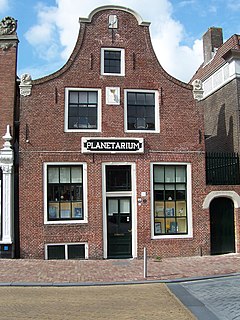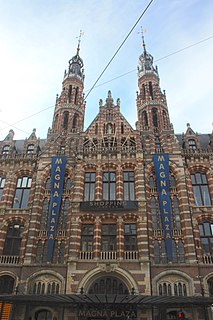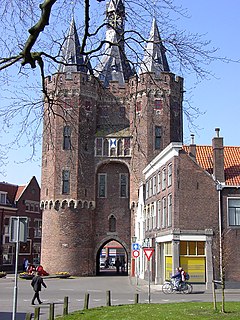| Franeker City Hall | |
|---|---|
| Stadhuis van Franeker | |
Franeker City Hall | |
| General information | |
| Type | Town hall |
| Architectural style | Renaissance |
| Location | Franeker, Netherlands |
| Address | Raadhuisplein 1 8801 KX, Franeker Netherlands |
| Construction started | 1591 |
| Completed | 1594 |
| References | |
| Dutch national monument registry | |
Franeker City Hall (Dutch: Stadhuis van Franeker) is the city hall of the municipality of Franeker, Netherlands, one of the eleven historical cities of Friesland. The building dates from 1591–1594 and was built in Frysian renaissance style.

Dutch(

Franeker is one of the eleven historical cities of Friesland and capital of the municipality of Waadhoeke. It is located north of the Van Harinxmakanaal and about 20 km west of Leeuwarden. As of 1 January 2014, it had 12,781 inhabitants. The Eise Eisinga Planetarium, established in 1781, is located in the city.

The Netherlands is a country located mainly in Northwestern Europe. The European portion of the Netherlands consists of twelve separate provinces that border Germany to the east, Belgium to the south, and the North Sea to the northwest, with maritime borders in the North Sea with Belgium, Germany and the United Kingdom. Together with three island territories in the Caribbean Sea—Bonaire, Sint Eustatius and Saba— it forms a constituent country of the Kingdom of the Netherlands. The official language is Dutch, but a secondary official language in the province of Friesland is West Frisian.
The first stone was laid on June 24, 1591. The building took a total of three years. Above the main entrance the coat of arms of Friesland is shown, and along the leadlights on the first floor, another 27 coats of arms are placed. It is a national monument and part of the Top 100 Dutch heritage sites. [1] It is a rijksmonument since February 21, 1967, and is one of only three Frisian entries in the Top 100 Dutch heritage sites.

Leadlights, leaded lights or leaded windows are decorative windows made of small sections of glass supported in lead cames. The technique of creating windows using glass and lead came is discussed at came glasswork. The term leadlight could be used to describe all windows in which the glass is supported by lead, but traditionally and correctly, a distinction is made between stained glass windows and leadlights, the former being associated with the ornate painted images on windows of churches and other such works of architecture and the latter with the windows of vernacular commercial and domestic architecture and defined by its simplicity.

A rijksmonument is a national heritage site of the Netherlands, listed by the agency Rijksdienst voor het Cultureel Erfgoed (RCE) acting for the Dutch Ministry of Education, Culture and Science.
The Top 100 Dutch heritage sites is a list of rijksmonuments in the Netherlands, established in 1990 by the Department for Conservation. The Top 100 was a selection of historical monuments that were authorized to display the symbol of the Hague Convention of 1954. The list should not be confused with the UNESCO World Heritage list. The buildings on the list could expect extra security in the context of the policy. The Top 100 list is no longer official, as the extra cultural protection policy is no longer applied. The following Top 100 also includes a list of the most important stained glass, church bells and organs.
The Dutch House in Brookline, Massachusetts, in the United States of America, was built as a partial copy of the Franeker City Hall, and is itself on the US National Register of Historic Places.

The Dutch House is a historic multi-unit residential building at 20 Netherlands Road in Brookline, Massachusetts. This four-story brick building was originally built as an exhibition hall at the 1893 World's Fair in Chicago, where it served as the Dutch Cocoa House. It is a close copy of the Franeker City Hall in Franeker, Netherlands. The door frame, embellished with stone animals, is a replica of the Enkhuizen Orphanage. The building's interior is highly ornate, with massive ceiling beams and Flemish wooden panels. The original dining room included classic blue and white Delftware tiles, some more than 300 years old. The exterior has a high mansard roof that extends over two floors, and has stepped gables. The windows include more than 12,000 individual lights of leaded green glass.

Brookline is a town in Norfolk County, Massachusetts, in the United States, and is a part of Greater Boston. Brookline borders six of Boston's neighborhoods: Brighton, Allston, Fenway–Kenmore, Mission Hill, Jamaica Plain, and West Roxbury. The city of Newton lies to the west of Brookline.

The National Register of Historic Places (NRHP) is the United States federal government's official list of districts, sites, buildings, structures, and objects deemed worthy of preservation for their historical significance. A property listed in the National Register, or located within a National Register Historic District, may qualify for tax incentives derived from the total value of expenses incurred preserving the property.



























